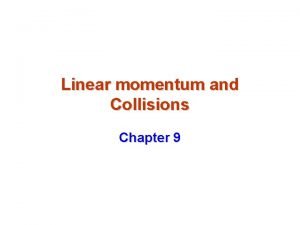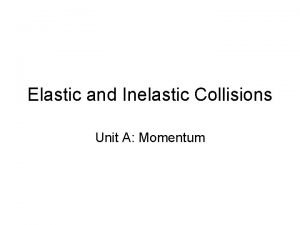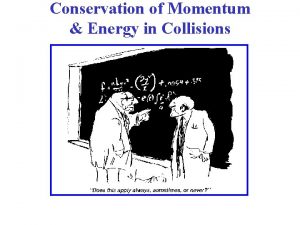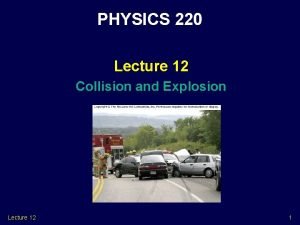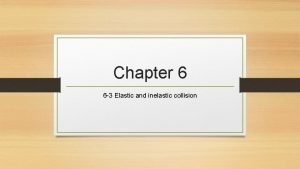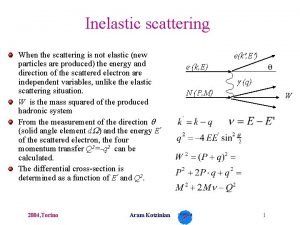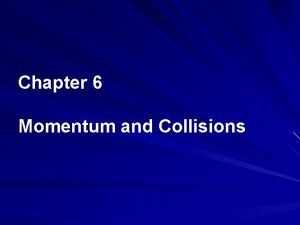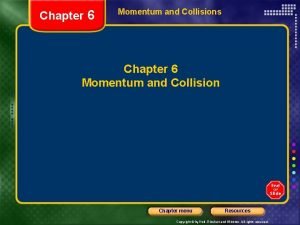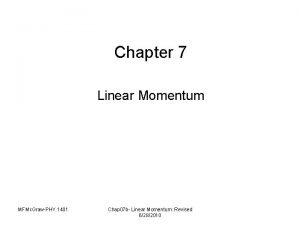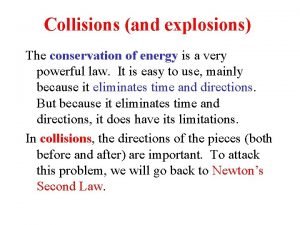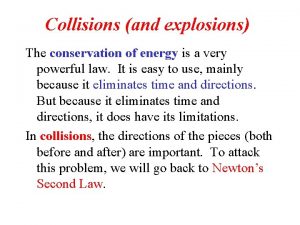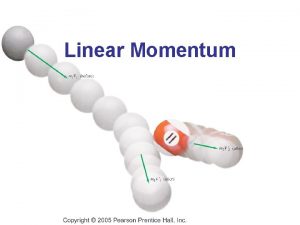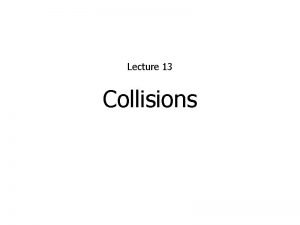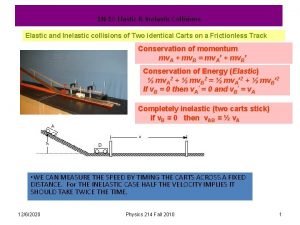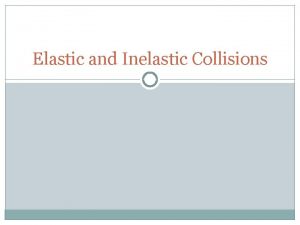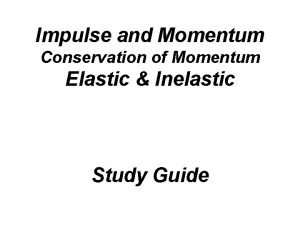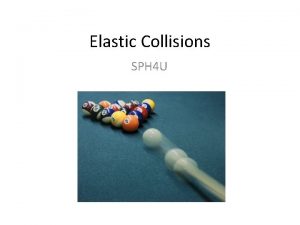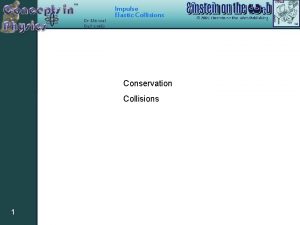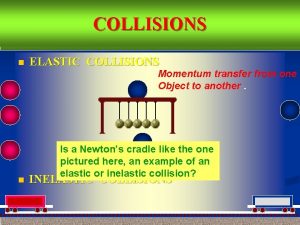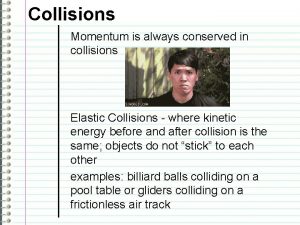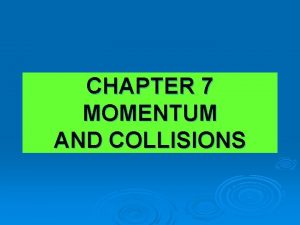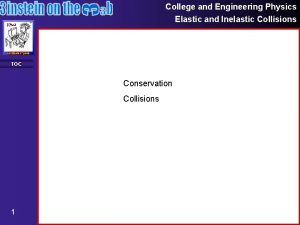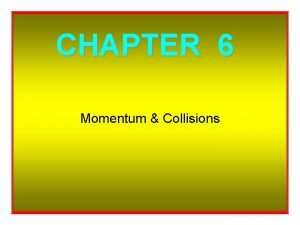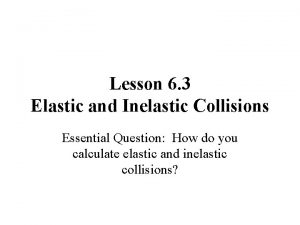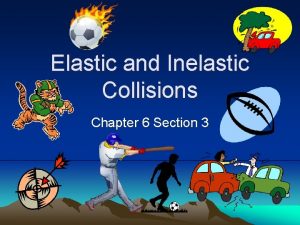Elastic and Inelastic Collisions Unit A Momentum Elasticity




















- Slides: 20

Elastic and Inelastic Collisions Unit A: Momentum

Elasticity of Collisions - In 1666, Newton demonstrated his colliding pendula to the Royal Society of London. - When one hardwood ball was released from a certain height to strike a second stationary ball, the moving ball stopped dead and the second rose to the height of release! (… and back and forth!) m. A = 1 m. B = 1 - Momentum is conserved: *

- If and , then and (1)(1) + (1)(0) = (1)(0) + (1)(1) 1 + 0 = 0 + 1 1 = 1 - But the law is also satisfied if: a) and (1)(1) + (1)(0) = (1)(0. 5) + (1)(0. 5) 1 + 0 = 0. 5 + 0. 5 1 = 1 b) or if and (1)(1) + (1)(0) = (1)(0. 2) + (1)(0. 8) 1 + 0 = 0. 2 + 0. 8 1 = 1 *

- Thus, there an infinite number of possible outcomes that would satisfy the Law of Conservation of Momentum but only one outcome ever happens! - How do the balls “know” what their final velocities should be? - In 1668, Christian Huygens had the answer: - When hard spheres collide, another quantity, mv 2, the “vis viva” (living force) was conserved as well as momentum Thus, there an infinite number of possible outcomes that would satisfy the Law of Conservation of Momentum but only one outcome ever happens! - Today we call the “vis viva” kinetic energy: *

- Huygens’ two types of collisions: 1. Elastic Collisions 2. Inelastic Collisions *


Collision Spectrum Perfectly Inelastic Somewhat Inelastic Somewhat Elastic Perfectly Elastic No Ek conserved Some Ek conserved Most Ek conserved All Ek conserved egg hits floor squash ball hit by racquet golf ball hit by club two electrons collide “fender bender” basketball is dribbled N 2(g) molecule hits O 2(g) molecule bullet imbeds in tree *

Elasticity of Collisions Example 1: Before A = 0. 532 kg = 3. 41 m/s R After A B = 0. 350 kg = 0 B = 0. 914 m/s R = 3. 72 m/s R *

Compare Ek to Ek :

Collision is somewhat elastic! So 15% Ek was converted to Ep! *

Example 2: Before B After A B A = 0. 350 kg = 0. 532 kg = - 0. 472 m/s 2. 49 m/s = 3. 32 m/s E v. A = 0 a) Compare to . *

b) Compare Ek to Ek : *

Collision is somewhat elastic! *

Example 3: Before B After A B A m. B = 0. 443 kg m. A = 0. 662 kg stuck together VB= 0 VA = 4. 11 m/s V A+B = 2. 48 m/s a) Compare to . *

experimental error! b) Compare Ek to Ek : *

Collision is not very elastic! *

Elastic Collision Problems (assume) Example 1: A Before: m. A = 4. 0 kg A = +6. 0 m/s B m. B = 2. 0 kg B = 0 After Elastic Collision: Using Conservation of Momentum: ( isolate a variable ) Equation #1 *

Using Conservation of Kinetic Energy: Multiply by 2 and substitute: Equation #2 *

Substitute for from Conservation of Momentum: Sub Equation #1 into Equation #2 Ax 2 + Bx + C = 0 A quadratic, so factor: ( ) = 0 Or if you’re CHICKEN! *

extraneous root Since was 6. 0 m/s, = +2. 0 ! So = 12 – 2 = 12– 2(2) = +8. 0 substitute into equation #1 *
 A freight train is being assembled in a switching yard
A freight train is being assembled in a switching yard Collision formula
Collision formula Elastic vs inelastic vs perfectly inelastic
Elastic vs inelastic vs perfectly inelastic Completely inelastic collision
Completely inelastic collision Elastic and inelastic collision
Elastic and inelastic collision Types of collisions worksheet
Types of collisions worksheet Non elastic scattering
Non elastic scattering Perfectly inelastic collision
Perfectly inelastic collision Type of momentum
Type of momentum A roller coaster climbs up a hill at 4m/s and then
A roller coaster climbs up a hill at 4m/s and then Chapter 6 momentum
Chapter 6 momentum Momentum is conserved in all collisions
Momentum is conserved in all collisions Perichondrium
Perichondrium Linear momentum
Linear momentum Conceptual physics momentum
Conceptual physics momentum Collisions and explosions
Collisions and explosions Collisions and explosions
Collisions and explosions Unitary elastic.
Unitary elastic. Elasticity mind map
Elasticity mind map Inelastic collision examples
Inelastic collision examples Energy lost in inelastic collision
Energy lost in inelastic collision

